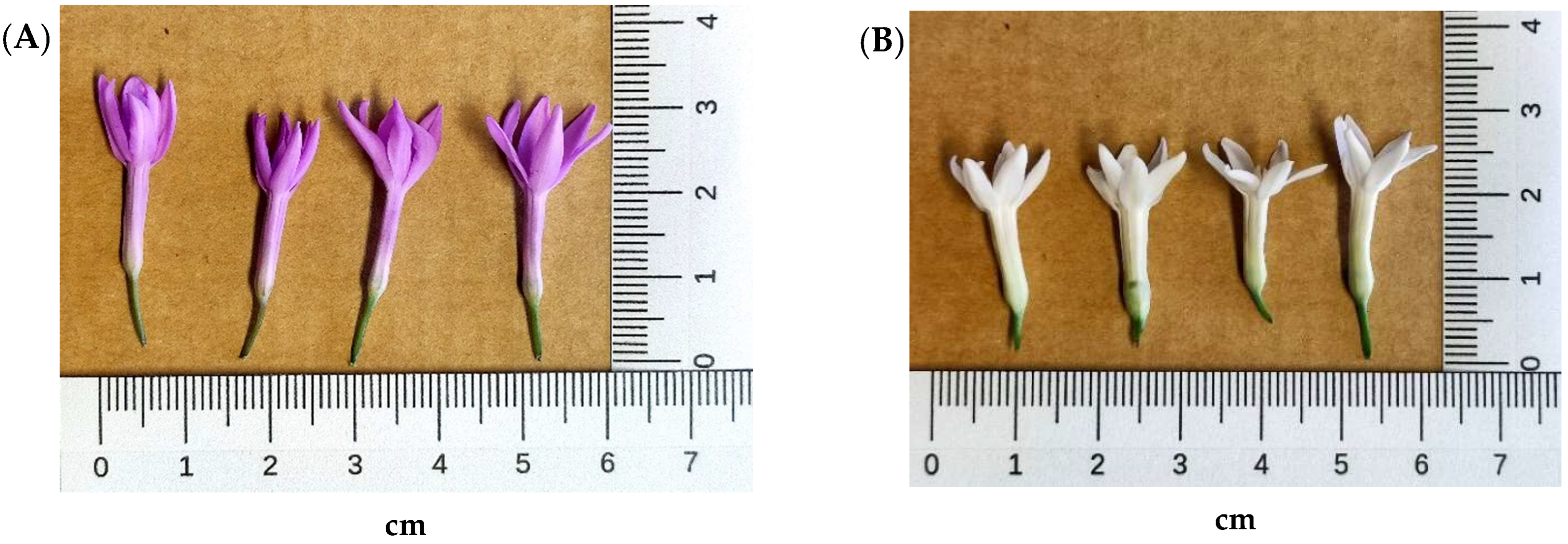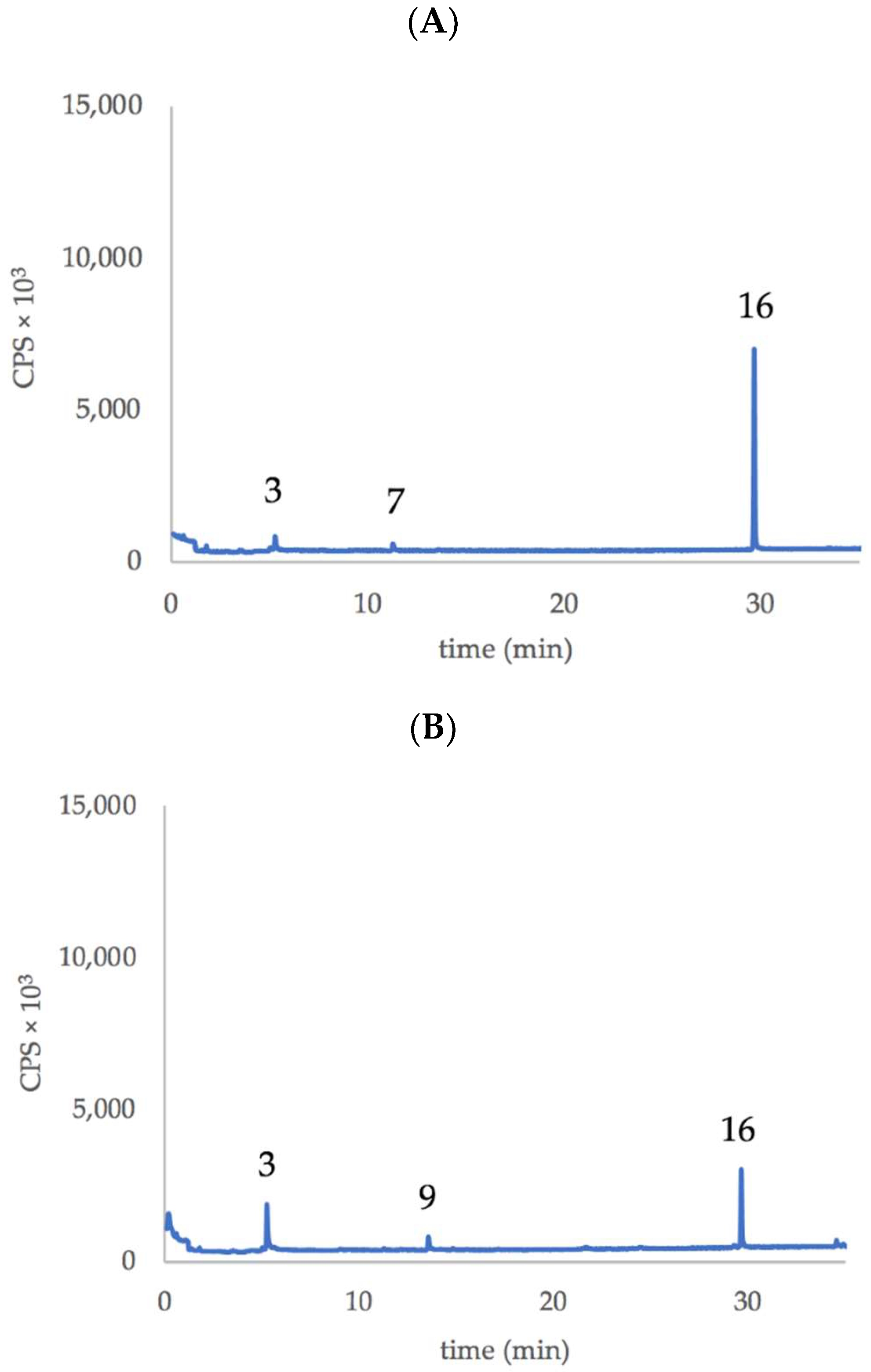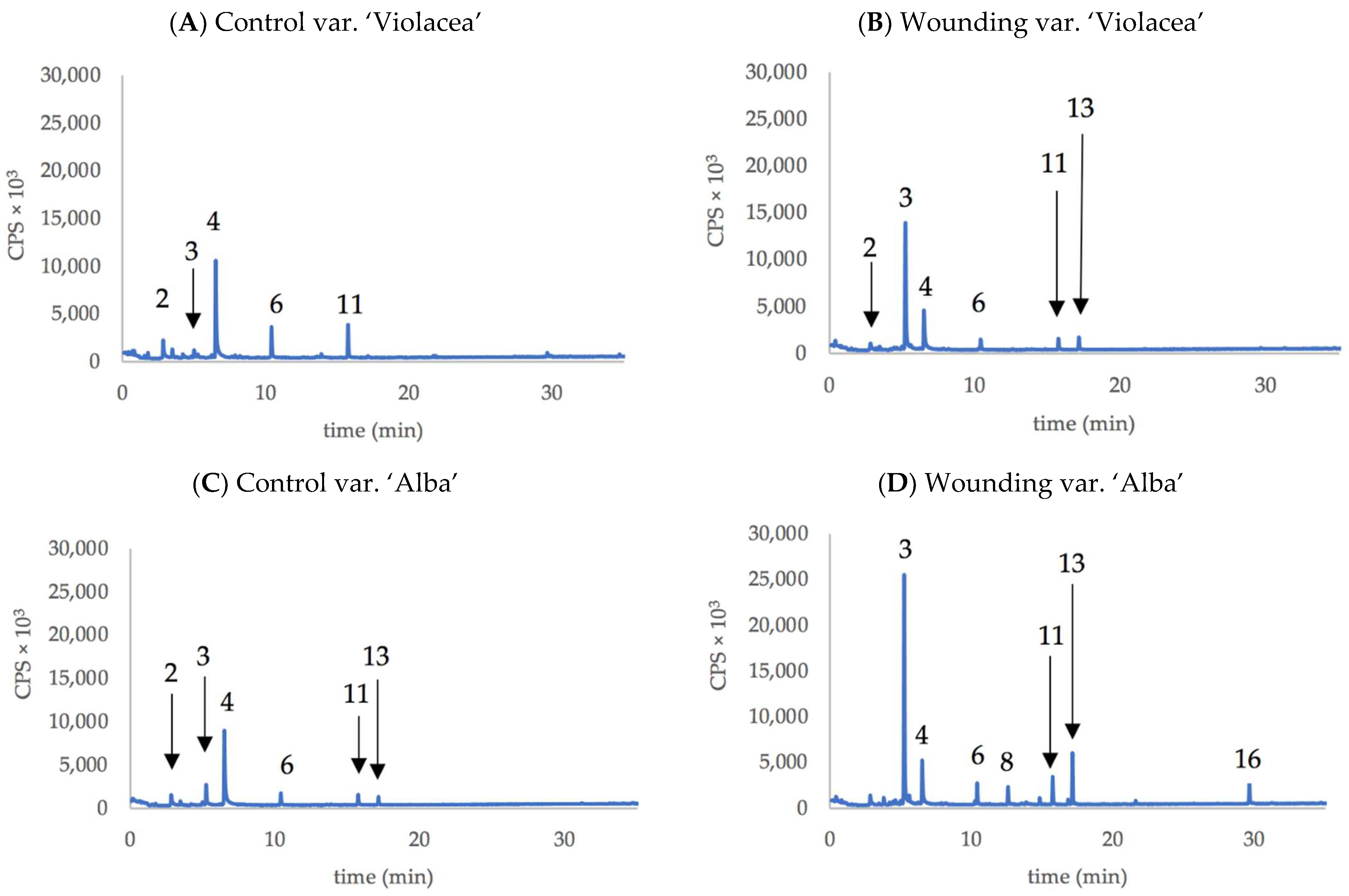The Green Leaf Volatile (Z)-3-Hexenyl Acetate Is Differently Emitted by Two Varieties of Tulbaghia violacea Plants Routinely and after Wounding
Abstract
1. Introduction
2. Results
2.1. Main Volatile Compounds Emitted by Tulbaghia Flowers
| No. | RI | Compound Name | Peak Area % | |
|---|---|---|---|---|
| Purple | White | |||
| 1 | 889 | 2,4-Dithiapentane | 0.51 | - |
| 3 | 991 | (Z)-3-Hexenyl acetate | 9.85 | 22.15 |
| 7 | 1134 | 2,3,5-Trithiahexane | 3.91 | 1.68 |
| 9 | 1175 | Benzyl 3-hydroxypropanoate | 1.32 | 5.54 |
| 10 | 1185 | (Z)-Butanoic acid, 3-hexenyl ester | 0.50 | 0.93 |
| 15 | 1501 | 4-Formyl-3,5-dimethyl-1H-pyrrole-2-carbonitrile | - | 0.56 |
| 16 | 1528 | 2,4,5,7-Tetrathiaoctane | 44.5 | 46.31 |
| No. | RI | Compound Name | Whole Plant | |||
|---|---|---|---|---|---|---|
| Var. ‘Violacea’ | Var. ‘Alba’ | |||||
| Control | Wounding | Control | Wounding | |||
| 2 | 934 | Benzaldehyde | + | + | + | + |
| 3 | 991 | (Z)-3-Hexenyl acetate | + | + | + | + |
| 4 | 1038 | Benzyl alcohol | + | + | + | + |
| 5 | 1098 | (Z)-3-Hexen-1-ol,propanoate | - | + | - | + |
| 6 | 1110 | Nonanal | + | + | + | + |
| 8 | 1170 | (Z)-1,7-Octadiene-3,6-diol,2,6-dimethyl | - | + | - | + |
| 10 | 1185 | (Z)-Butanoic acid, 3-hexenyl ester | - | + | - | + |
| 11 | 1206 | Decanal | + | + | + | + |
| 12 | 1215 | (Z)-1,6-Octadien-3-ol,3,7-dimethyl-formate | - | + | - | + |
| 13 | 1226 | (Z)-3-Hexenyl-α-methylbutyrate | + | + | + | + |
| 14 | 1275 | (Z)-Hex-3-enyl(E)-2-methylbut-2-enoate | - | + | - | + |
| 16 | 1528 | 2,4,5,7-Tetrathiaoctane | + | + | - | + |
2.2. Volatile Compounds Emitted by Whole Tulbaghia Plants
3. Discussion
4. Materials and Methods
4.1. Plant Culture Conditions
4.2. Analysis of Volatile Organic Compounds
4.3. Statistics
Author Contributions
Funding
Data Availability Statement
Conflicts of Interest
References
- Dillon, H.; Nelson, E.C. 166. Tulbaghia leucantha: Alliaceae. Kew Mag. 1991, 8, 12–15. Available online: http://www.jstor.org/stable/45067180 (accessed on 12 August 2022).
- Lyantagaye, S.L. Ethnopharmacological and phytochemical review of Allium species (sweet garlic) and Tulbaghia species (wild garlic) from Southern Africa. Tanzan. J. Sci. 2011, 37, 58–72. Available online: https://www.ajol.info/index.php/tjs/article/view/73615 (accessed on 12 August 2022).
- Ranglová, K.; Krejčová, P.; Kubec, R. The effect of storage and processing on antimicrobial activity of Tulbaghia violacea. S. Afr. J. Bot. 2015, 97, 159–164. [Google Scholar] [CrossRef]
- Kubec, R.; Velísek, J.; Musah, R.A. The amino acid precursors and odor formation in society garlic (Tulbaghia violacea Harv.). Phytochemistry 2002, 60, 21–25. [Google Scholar] [CrossRef]
- Kubec, R.; Krejčová, P.; Mansur, L.; García, N. Flavor Precursors and Sensory-Active Sulfur Compounds in Alliaceae Species Native to South Africa and South America. J. Agric. Food Chem. 2013, 61, 1335–1342. [Google Scholar] [CrossRef]
- Ameye, M.; Allmann, S.; Verwaeren, J.; Smagghe, G.; Haesaert, G.; Schuurink, R.C.; Audenaert, K. Green leaf volatile production by plants: A meta-analysis. New Phytol. 2018, 220, 666–683. [Google Scholar] [CrossRef]
- Engelberth, J.; Alborn, H.T.; Schmelz, E.A.; Tumlinson, J.H. Airborne signals prime plants against insect herbivore attack. Proc. Natl. Acad. Sci. USA 2004, 101, 1781–1785. [Google Scholar] [CrossRef]
- Li, T.; Cofer, T.; Engelberth, M.; Engelberth, J. Defense Priming and Jasmonates: A Role for Free Fatty Acids in Insect Elicitor-Induced Long Distance Signaling. Plants 2016, 5, 5. [Google Scholar] [CrossRef]
- Meents, A.K.; Mithöfer, A. Plant-Plant Communication: Is There a Role for Volatile Damage-Associated Molecular Patterns? Front. Plant Sci. 2020, 11, 583275. [Google Scholar] [CrossRef]
- Laohakunjit, N.; Kerdchoechuen, O.; Matta, F.B.; Silva, J.L.; Holmes, W.E. Postharvest Survey of Volatile Compounds in Five Tropical Fruits Using Headspace-solid Phase Microextraction (HS-SPME). HortScience 2007, 42, 309–314. [Google Scholar] [CrossRef]
- Mostafa, S.; Wang, Y.; Zeng, W.; Jin, B. Floral Scents and Fruit Aromas: Functions, Compositions, Biosynthesis, and Regulation. Front. Plant Sci. 2022, 13, 860157. [Google Scholar] [CrossRef]
- Zhang, W.; Zhu, G.; Zhu, G. The imitation and creation of a mango flavor. Food Sci. Technol. 2022, 42, e34622. [Google Scholar] [CrossRef]
- Chehab, E.; Kaspi, R.; Savchenko, T.; Dehesh, K. Hexenyl acetate mediates indirect plant defense responses. Proc. ANAS (Biol. Sci.) 2010, 65, 145–151. [Google Scholar]
- Griffiths, G. Biosynthesis and analysis of plant oxylipins. Free Radic. Res. 2015, 49, 565–582. [Google Scholar] [CrossRef] [PubMed]
- Wasternack, C.; Feussner, I. The Oxylipin Pathways: Biochemistry and Function. Annu. Rev. Plant Biol. 2018, 69, 363–386. [Google Scholar] [CrossRef] [PubMed]
- Devoto, A.; Turner, J.G. Regulation of jasmonate-mediated plant responses in Arabidopsis. Ann. Bot. 2003, 92, 329–337. [Google Scholar] [CrossRef]
- Griffiths, G. Jasmonates: Biosynthesis, perception and signal transduction. Essays Biochem. 2020, 64, 501–512. [Google Scholar] [CrossRef] [PubMed]
- Sohn, S.-I.; Pandian, S.; Rakkammal, K.; Largia, M.J.V.; Thamilarasan, S.K.; Balaji, S.; Zoclanclounon, Y.A.B.; Shilpha, J.; Ramesh, M. Jasmonates in plant growth and development and elicitation of secondary metabolites: An updated overview. Front. Plant Sci. 2022, 13, 942789. [Google Scholar] [CrossRef]
- Pino, J.A.; Quijano-Celís, C.E.; Fuentes, V. Volatile compounds of Tulbaghia violacea harv. J. Essent. Oil-Bear. Plants 2008, 11, 203–207. [Google Scholar] [CrossRef]
- Richter, J.M.; Prinsloo, G.J.; Van Der Linde, T.C.D.K. The Response of Alate Diuraphis noxia (Kurdjumov) (Hemiptera: Aphididae) to Volatile Substances from Four Non-Host Plant Extracts Under Laboratory Conditions. Afr. Entomol. 2014, 22, 783–789. [Google Scholar] [CrossRef]
- Xavier, L.M.S.; Laumann, R.A.; Borges, M.; Magalhães, D.M.; Vilela, E.F.; Blassioli-Moraes, M.C. Trichogramma pretiosum attraction due to the Elasmopalpus lignosellus damage in maize. Pesq. Agropec. Bras. 2011, 46, 578–585. [Google Scholar] [CrossRef][Green Version]
- Espadas-Pinachoa, K.; López-Guillénb, L.; Gómez-Ruiza, J.; Cruz-Lópeza, L. Induced volatiles in the interaction between soybean (Glycine max) and the Mexican soybean weevil (Rhyssomatus nigerrimus). Braz. J. Biol. 2021, 81, 611–620. [Google Scholar] [CrossRef] [PubMed]
- Arimura, G.; Ozawa, R.; Shimoda, T.; Nishioka, T.; Boland, W.; Takabayashi, J. Herbivory-induced volatiles elicit defense genes in lima bean leaves. Nature 2000, 406, 512–515. [Google Scholar] [CrossRef] [PubMed]
- Ozawa, R.; Shimoda, T.; Kawaguchi, M.; Arimura, G.; Horiuchi, J.; Nishioka, T.; Takabayashi, J. Lotus japonicus infested with herbivorous mites emits volatile compounds that attract predatory mites. J. Plant Res. 2000, 113, 427–433. [Google Scholar] [CrossRef]
- Hegde, M.; Oliveira, J.N.; da Costa, J.G.; Bleicher, E.; Goulart Santana, A.E.; Bruce, T.J.A.; Caulfield, J.; Dewhirst, S.Y.; Woodcock, C.M.; Pickett, J.A.; et al. Identification of semiochemicals released by cotton, Gossypium hirsutum, upon infestation by the cotton aphid, Aphis gossypii. J. Chem. Ecol. 2011, 37, 741–750. [Google Scholar] [CrossRef] [PubMed]
- Qiao, F.; Cai, Z.-P.; Su, J.-W. Herbivore-induced wheat volatiles facilitate biocontrol of the cereal aphid by the multicolored Asian ladybeetle. Chin. J. Entomol. 2020, 57, 189–195. [Google Scholar] [CrossRef]
- Sun, Y.-L.; Dong, J.-F.; Huang, L.-Q.; Wang, C.-Z. The cotton bollworm endoparasitoid Campoletis chlorideae is attracted by cis-jasmone or cis-3-hexenyl acetate but not by their mixtures. Arthropod Plant Interact. 2020, 14, 169–179. [Google Scholar] [CrossRef]
- Sun, Y.-L.; Dong, J.-F.; Song, Y.-Q.; Wang, S.-L. GOBP1 from the Variegated Cutworm Peridroma saucia (Hübner) (Lepidoptera: Noctuidae) Displays High Binding Affinities to the Behavioral Attractant (Z)-3-Hexenyl acetate. Insects 2021, 12, 939. [Google Scholar] [CrossRef]
- Wei, H.-s.; Qin, J.-h.; Cao, Y.-z.; Li, K.-b.; Yin, J. Two classic OBPs modulate the responses of female Holotrichia oblita to three major ester host plant volatiles. Insect Mol. Biol. 2021, 30, 390–399. [Google Scholar] [CrossRef]
- Li, P.; Zhu, J.; Qin, Y.J. Enhanced Attraction of Plutella xylostella (Lepidoptera: Plutellidae) to Pheromone-Baited Traps With the Addition of Green Leaf Volatiles. Econ. Entomol. 2012, 105, 1149–1156. [Google Scholar] [CrossRef]
- Yu, H.; Feng, J.; Zhang, Q.; Xu, H. (Z)-3-hexenyl acetate and 1-undecanol increase male attraction to sex pheromone trap in Grapholita molesta (Busck) (Lepidoptera: Tortricidae). Int. J. Pest Manag. 2014, 61, 30–35. [Google Scholar] [CrossRef]
- Vuts, J.; Furlan, L.; Tóth, M. Female Responses to Synthetic Pheromone and Plant Compounds in Agriotes brevis Candeze (Coleoptera: Elateridae). J. Insect Behav. 2018, 31, 106–117. [Google Scholar] [CrossRef]
- Ju, Q.; Li, X.; Guo, X.-Q.; Du, L.; Shi, C.-R.; Qu, M.-J. Two Odorant-Binding Proteins of the Dark Black Chafer (Holotrichia parallela) Display Preferential Binding to Biologically Active Host Plant Volatiles. Front. Physiol. 2018, 9, 769. [Google Scholar] [CrossRef] [PubMed]
- Xin, Z.-J.; Li, X.-W.; Bian, L.; Sun, X.-L. Tea green leafhopper, Empoasca vitis, chooses suitable host plants by detecting the emission level of (3Z)-hexenyl acetate. Bull. Entomol. Res. 2017, 107, 77–84. [Google Scholar] [CrossRef]
- Chen, P.; Dai, C.; Liu, H.; Hou, M. Identification of Key Headspace Volatile Compounds Signaling Preference for Rice over Corn in Adult Females of the Rice Leaf Folder Cnaphalocrocis medinalis. J. Agric. Food Chem. 2022, 70, 9826–9833. [Google Scholar] [CrossRef]
- Najdabbasi, N.; Mirmajlessi, S.M.; Dewitte, K.; Ameye, M.; Mänd, M.; Audenaert, K.; Landschoot, S.; Haesaert, G. Green Leaf Volatile Confers Management of Late Blight Disease: A Green Vaccination in Potato. J. Fungi 2021, 7, 312. [Google Scholar] [CrossRef] [PubMed]
- Ameye, M.; Audenaert, K.; De Zutter, N.; Steppe, K.; Van Meulebroek, L.; Vanhaecke, L.; De Vleesschauwer, D.; Haesaert, G.; Smagghe, G. Priming of Wheat with the Green Leaf Volatile Z-3-Hexenyl Acetate Enhances Defense against Fusarium graminearum But Boosts Deoxynivalenol Production. Plant Physiol. 2015, 167, 1671–1684. [Google Scholar] [CrossRef]
- McCall, P.J.; Turlings, T.C.J.; Loughrin, J.; Proveaux, A.T.; Tumlinson, J.H. Herbivore-induced volatile emissions from cotton (Gossypium hirsutum L.) seedlings. J. Chem. Ecol. 1994, 20, 12. [Google Scholar] [CrossRef]
- Negro, C.; Dimita, R.; Min Allah, S.; Miceli, A.; Luvisi, A.; Blando, F.; De Bellis, L.; Accogli, R. Phytochemicals and Volatiles in Developing Pelargonium ‘Endsleigh’ Flowers. Horticulturae 2021, 7, 419. [Google Scholar] [CrossRef]
- Dimita, R.; Min Allah, S.; Luvisi, A.; Greco, D.; De Bellis, L.; Accogli, R.; Mininni, C.; Negro, C. Volatile Compounds and Total Phenolic Content of Perilla frutescens at Microgreens and Mature Stages. Horticulturae 2022, 8, 71. [Google Scholar] [CrossRef]
- NIST (National Institute of Standards and Technology) Computational Chemistry Comparison and Benchmark Database NIST Standard Reference Database Number 101. [CrossRef]
- Zhao, Y.Z.; Li, Z.G.; Tian, W.L.; Fang, X.M.; Su, S.K.; Peng, W.J. Differential Volatile Organic Compounds in Royal Jelly Associated with Different Nectar Plants. J. Integr. Agric. 2016, 15, 1157–1165. [Google Scholar] [CrossRef]




| Flower | (Z)-3-Hexenyl Acetate (ng/g FW) |
|---|---|
| Purple | 124.18 ± 6.28 |
| White | 314.56 ± 15.19 |
| Tulbaghia Variety | (Z)-3-Hexenyl Acetate (ng/plant) | Increase (%) | |
|---|---|---|---|
| Control | Wounding | ||
| ‘Violacea’ | 28 ± 1 | 1300 ± 62 | 4463 |
| ‘Alba’ | 216 ± 10 | 2212 ± 109 | 926 |
Publisher’s Note: MDPI stays neutral with regard to jurisdictional claims in published maps and institutional affiliations. |
© 2022 by the authors. Licensee MDPI, Basel, Switzerland. This article is an open access article distributed under the terms and conditions of the Creative Commons Attribution (CC BY) license (https://creativecommons.org/licenses/by/4.0/).
Share and Cite
Frontini, A.; De Bellis, L.; Luvisi, A.; Blando, F.; Allah, S.M.; Dimita, R.; Mininni, C.; Accogli, R.; Negro, C. The Green Leaf Volatile (Z)-3-Hexenyl Acetate Is Differently Emitted by Two Varieties of Tulbaghia violacea Plants Routinely and after Wounding. Plants 2022, 11, 3305. https://doi.org/10.3390/plants11233305
Frontini A, De Bellis L, Luvisi A, Blando F, Allah SM, Dimita R, Mininni C, Accogli R, Negro C. The Green Leaf Volatile (Z)-3-Hexenyl Acetate Is Differently Emitted by Two Varieties of Tulbaghia violacea Plants Routinely and after Wounding. Plants. 2022; 11(23):3305. https://doi.org/10.3390/plants11233305
Chicago/Turabian StyleFrontini, Alessandro, Luigi De Bellis, Andrea Luvisi, Federica Blando, Samar Min Allah, Rosanna Dimita, Carlo Mininni, Rita Accogli, and Carmine Negro. 2022. "The Green Leaf Volatile (Z)-3-Hexenyl Acetate Is Differently Emitted by Two Varieties of Tulbaghia violacea Plants Routinely and after Wounding" Plants 11, no. 23: 3305. https://doi.org/10.3390/plants11233305
APA StyleFrontini, A., De Bellis, L., Luvisi, A., Blando, F., Allah, S. M., Dimita, R., Mininni, C., Accogli, R., & Negro, C. (2022). The Green Leaf Volatile (Z)-3-Hexenyl Acetate Is Differently Emitted by Two Varieties of Tulbaghia violacea Plants Routinely and after Wounding. Plants, 11(23), 3305. https://doi.org/10.3390/plants11233305











